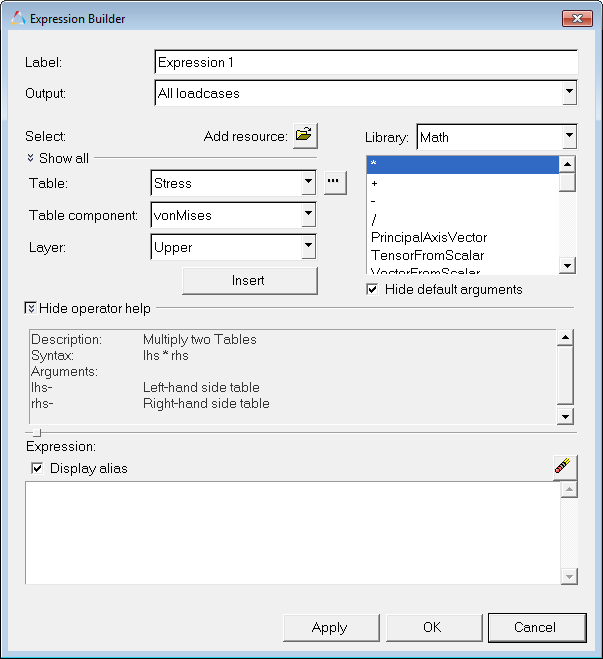Table Selection |

|

|

|

|
|
Table Selection |

|

|

|

|
Once an operator is selected, tables must be selected to form the input. The table selection portion of the dialog lists all of the tables available, and optionally extended selection drop-downs to enable a table to be addressed from another frame, load case, or even from a different resource. Click on the Show all drop-down arrow to display the full list of table options.

Expression Builder with the table selection section expanded to Show all
Once a table address is specified, it can be added to the expression (at the current insertion point that corresponds to the argument being defined) by clicking the Insert button. This will add a table address, however it will be a short-hand form that allows long expressions to be authored without having to deal with long data type names.
Table address aliases use a four-section dot-separated list that breaks down the address by load case/frame, data type, component, and layer:
LCnFn.{S|V|T}n.Cn.Ln
Where:
n = index (load case index, frame index, table index, component index, etc.)
LC = load case
F = frame (simulation step)
{S|V|T} = Scalar, Vector, Tensor
C = Component (valid only for vector or tensor tables).
L = Layer index
The index is a 1-based array index (the first entry is 1, not 0). For example, T1 is a reference to the 1st tensor table. The full specification of a table is not mandatory, and typically consists of the data type section only. For example:
Table |
Address |
Reference |
|---|---|---|
T1.C1 |
1st tensor, 1st component |
Stress, XX (scalar, two layers: Z1 & Z2). |
T2. |
2nd tensor |
Strain (tensor, two layers: Z1 & Z2). |
T2.C3.L1 |
2nd tensor, 3rd component, 1st layer |
Strain, ZZ, Z1 (scalar, no layers) |
V2 |
2nd vector |
Rotation (vector) |
Table references can be made to resources only, and not to tables that are user-defined as a result of an expression. For example, if you define a new tensor, it cannot be addressed in an expression.
When creating/editing an expression, the Expression Builder dialog has a Display alias checkbox that is enabled by default:

To review the full table addresses, uncheck the Display alias checkbox:

| Note | The expression must be syntactically correct and complete in order to view the long form. |
Expression editing is disabled when the Display alias box is unchecked.